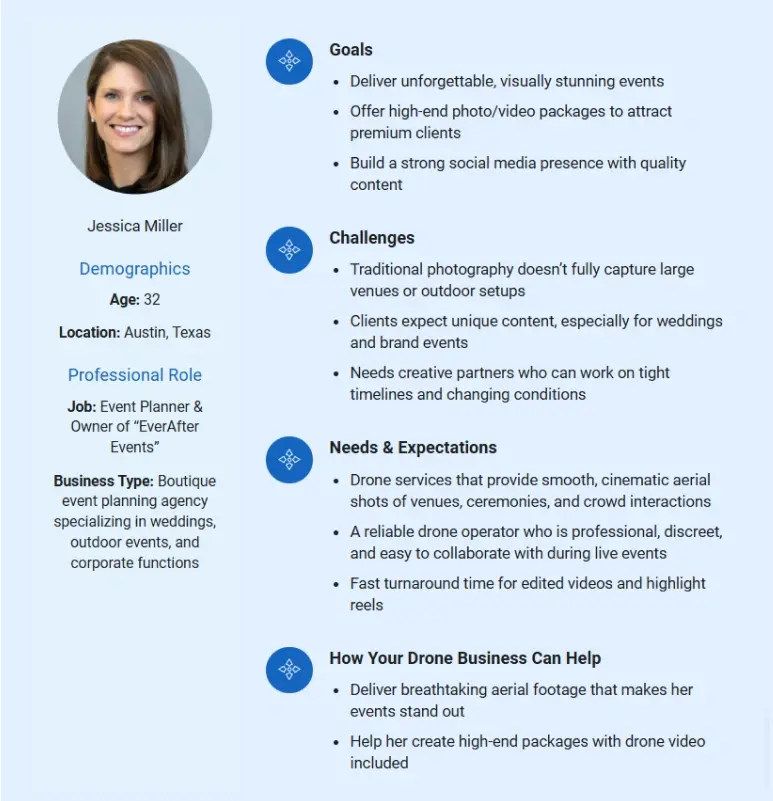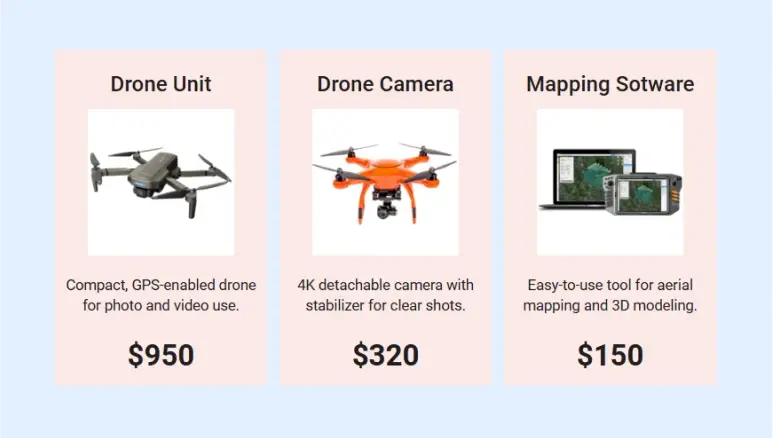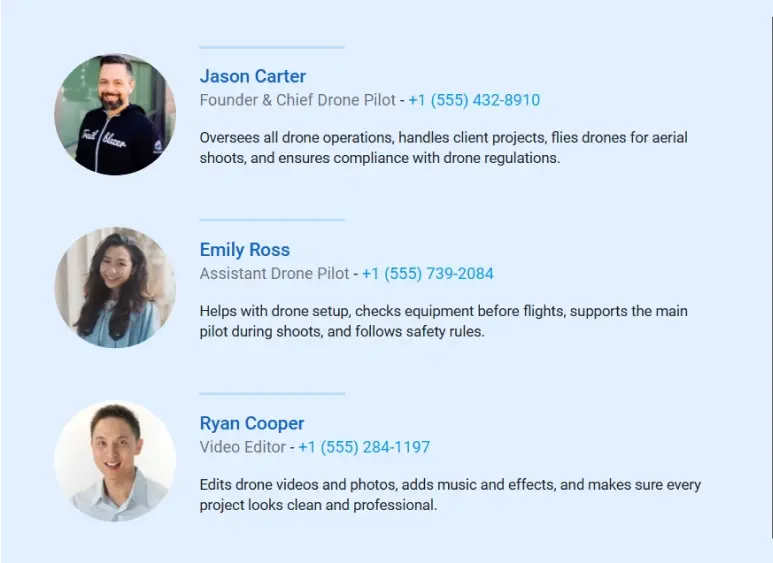Finding clients for your drone business feels hard? Unsure how to set fair prices or convince investors your plan will work? Many drone operators struggle with turning their skills into a steady income.
That’s why we created this template. It’s built to help you organize your ideas, show your value, and create a plan you can actually use to grow.
Download this free drone business plan template and take the first step toward a more professional, profitable drone business.
Keep reading for tips on how to use the template or create a plan that’s investor-ready.
How to Write a Drone Business Plan?
A strong drone business plan follows a simple, clear structure. We’ll break down each part step by step so you can build your plan easily.
Here’s a step-by-step guide to creating your drone business plan:
1. Executive Summary
The executive summary gives a quick look at your drone business and why it has a strong chance of success.
Even though it comes at the beginning of your plan, it’s easier to write it after you’ve completed all the other sections. That way, you can pick the most important points and keep them short and clear.
While planning this section, try to cover the following aspects in just one or two pages :
- What your drone business is about and where you’ll run it
- What your business stands for (mission) and your long-term dream (vision)
- What makes your services different or better than others
- Who your main customers will be
- How much funding (if any) you need to get started or grow
- What your financial goals are, like expected profits or growth plans
Keep it short and easy to understand. This section should catch people’s attention and make them want to learn more about your drone business. So, it’s your chance to show why your business is special and why it will do well.
Say goodbye to boring templates
Build your business plan faster and easier with AI
Plans starting from $14/month

2. Business Overview
The business overview section gives a simple background of your drone business. It explains what your business does, why it matters, and what you plan to achieve.
Start by describing what kind of drone company you run and the name of it. You may specialize in one of the following drone businesses:
- Drone photography business
- Drone manufacturing business
- Agriculture drone services
- Drone delivery services
- Drone racing and entertainment
Also, explain where your business is located and why you selected that place. Describe the legal structure of your drone business, whether it’s a sole proprietorship, LLC, partnership, or other.
If you’re an established drone business, briefly describe your background history, including when it was founded, how it evolved over time, etc.
Next, provide your mission and vision statement. Your mission is what your business wants to do. For instance: “To provide safe and high-quality drone services for photos, videos, and inspections.”
Don’t forget to add your vision statement as well. Your vision is your long-term goal, like becoming a trusted drone service in your area.
Then, say what problem you are solving. For example, helping people get better property photos, or making land checks faster and easier for farmers or builders.
Lastly, mention your short-term and long-term goals, like to find first clients or working in more places.
Overall, this section should provide a thorough understanding of your business, its history, and its future plans. Keep this section engaging, precise, and to the point.
3. Market Analysis
The market analysis section shows that you understand the drone industry and the market you want to serve. It helps prove that there’s a real need for your services and that you know how to compete.
Start by talking about the drone industry. Is it growing or not? You can also include a fact, like:
“The global drone market was valued at $73.06 billion in 2024 and is projected to reach $163.60 billion by 2030.”
This shows that more people and businesses want drone services.
Next, think about who you want to work with. Real estate agents who need property photos? Farmers who want to check their crops? Event planners who need aerial videos? Or construction companies that need site inspections?
Creating a detailed buyer persona will help you easily define your target market, their needs, and preferences. Here’s an example to help you create your own:

Also, mention trends that help your business grow. For example:
- More people want drone photos and videos for marketing.
- Farmers are using drones to check their fields faster.
- Drone footage is now popular on social media and websites.
Then, identify and analyze your direct and indirect competitors.
Direct competitors: Other drone service providers in your area.
Indirect competitors: Traditional photographers who don’t use drones.
Identify their strengths and weaknesses, and describe what differentiates your drone services from theirs. Point out how you have a competitive edge in the market.
List regulations and licensing requirements that may affect your drone company, such as business registration, no-fly zones or restricted area regulations, privacy & data protection, flight restrictions, etc.
People reading this section should clearly understand your market, who your customers are, and why your drone business is likely to succeed.
4. Products And Services
The products and services section explains what your drone business will offer. It defines how you plan to earn money while helping your customers.
To write this section, include the following:
Your drone products and services
Mention the drone products and services your business will offer. For example:
For each offering, mention how it helps the customer—like saving time, cutting costs, or getting better results.
Pricing
Talk about how you’ll charge for your services:
- One-time fees per project (like a wedding or house shoot)
- Hourly rates for longer jobs
- Monthly or package plans for regular clients (like real estate companies)
For drone products, you can set pricing like:

And for drone services, you may charge $65 for real estate photos and videos, $100 for outdoor events like weddings or parties, and $45 for quick roof inspections. These prices are examples of what many drone businesses typically charge.
Keep your pricing simple and clear. If you offer custom pricing based on the job, say that too.
Quality measures
This section should explain how you maintain quality standards and consistently provide the highest quality service. This may include safety protocols, pilot training & certification, data accuracy & quality, insurance coverage, etc.
Future Plans
If you plan to add more services in the future—like video editing, drone training, or renting drones—mention that as part of your growth.
By the end of this section, people should understand exactly what you offer and how your drone services are useful.
5. Sales And Marketing Strategies
Running a drone business can be a bit tricky. Many people don’t know how drones can help them, so you can’t just wait for them to contact you. You need to show what you do in a clear, friendly way and build trust with your customers.
This part explains how you’ll tell people about your drone services and get them to hire you.
Marketing Strategies
Here are some easy methods to promote your drone business:
- Make a simple website and post your drone photos and videos on Instagram, Facebook, and YouTube.
- Add your business on Google Maps so people nearby can find you.
- Run online ads to reach people like real estate agents, farmers, and event planners.
- Work with real estate offices, wedding planners, and builders who may need your services often.
- Go to local events or exhibitions to show what you do.
- Give discounts to new customers to get your first few bookings.
Sales Strategies
The following are some ways to turn people into paying customers:
- Give free consultations to understand what they need.
- Show examples of your past work to gain trust.
- Send a clear price list with what’s included in each service.
- Follow up quickly if someone shows interest.
- Offer different packages (basic, standard, premium) so they can choose what suits their budget.
These steps will help more people learn about your drone business and make it easy for them to hire you.
6. Operations Plan
This part explains how the drone business will work every day. It shows that everything is well planned and organized to give a good service.
Here are a few questions you need to answer when drafting this section:
- Where will you work from? Will you work from home or rent an office?
- How will customers contact you? Will people message you through your website, social media, phone, or email?
- Will you use apps for bookings, payments, editing, or drone mapping?
- Will you team up with real estate agents, event planners, or builders who might need drone services often?
- Are you doing everything by yourself right now? Will you hire someone to help later (like a drone pilot or editor)?
- How will you keep customers happy? Will you deliver work on time, talk clearly with clients, and ask for feedback to improve?
In short, this section shows potential lenders that you can run your drone business smoothly and give a great experience to your customers.
7. Management Team
The management team section explains who is running the drone business and how their skills will help it grow.
Start with yourself. If you’re the owner, write a short intro—like if you’ve worked with drones before, done photography, or have experience in tech or flying.
If you have other team members, like a drone pilot, video editor, or someone who handles bookings and clients, mention them. For each team member, mention their experience, skills, roles, and what they’re good at.

You can also show a simple organizational chart of your team to explain who reports to whom and how the decisions are made.
If any mentors, drone experts, or business advisors are helping you, include them too. It shows you have support and boosts the credibility of your plan.
This section helps people understand that your team knows what they’re doing and can run the drone business well.
8. Financial Plan
The financial plan section explains how much money your drone business will need to start, what you’ll spend regularly, and how you’ll earn. It helps show that your drone services can be profitable and financially sustainable.
Startup costs
Start by listing the one-time costs to get your drone business off the ground. These may include:
- Buying drones and spare batteries
- Drone licenses and insurance
- Video editing software
- Marketing materials and website setup
- Laptop or tablet for editing and planning
- Travel gear (backpacks, cases, etc.)
Revenue projections
Next, estimate your income for the next 3–5 years. Drone businesses can earn money through:
- Aerial photography and videography
- Real estate shoots
- Event coverage (weddings, festivals, etc.)
- Agricultural drone surveys
- Roof and building inspections
- Promotional videos for local businesses
This helps show how your business will bring in money from different services.
Expense projections
Now, list your expected monthly and yearly expenses. These could include:
- Drone maintenance and repairs
- Software subscriptions (editing, mapping, etc.)
- Internet and phone bills
- Marketing and ads
- Fuel and travel costs
- Assistant or freelance editor payments (if any)
- Insurance and license renewals
Showing that you understand both fixed and variable costs helps build confidence.
Financial statements
Include a summary of the key financial statements:
- Profit and loss statement
- Cash flow statement
- Balance sheet
You can also mention your break-even point—when your income will start covering your costs.
Funding needs
If you need funding to start or grow, mention how much you’re seeking and what it’ll be used for. For example:
- $10,000 for drones and editing equipment
- $3,000 for marketing and website
- $2,000 for insurance and legal setup
A simple pie chart or breakdown makes it easier for readers to see where the money will go.
This section should give a clear, honest picture of how your drone business will manage money and how it can grow over time.
9. Appendix
Sometimes you have extra details that don’t fit into the main parts of your business plan, but they’re still important. That’s where the appendix comes in.
It’s an optional section where you can include helpful information for anyone who wants to know more about your drone business, like investors or partners.
You can include things like:
- Your service packages and pricing
- Drone photos or video samples from past projects
- List of drones, cameras, or software you use
- Your resume or team profiles
- Pilot licenses, permits, or insurance documents
- Customer reviews or feedback
- Financial breakdowns and sales forecasts
- Research or data about the drone industry
Not everyone will read this part, but it’s helpful for investors, partners, or anyone who wants to see more proof that you’re ready and serious about your business.
Download a free drone business plan template
Ready to start your drone business, but not sure where to begin? Don’t worry! Download our free drone business plan template PDF to get started.
This easy-to-use template is made just for drone service providers like you. It includes real examples and helpful tips to guide you through building a strong plan—whether you need it for funding, partnerships, or running a smooth, successful business.
The Quickest Way to turn a Business Idea into a Business Plan
Fill-in-the-blanks and automatic financials make it easy.
Conclusion
Now that you’ve learned how to create a solid drone business plan, you’re in a much better position to set goals, attract clients, and grow your business the right way.
Still feeling unsure or want to make the process even faster? Upmetrics can help.
It comes with smart features like an advanced AI Assistant, a pitch deck generator, financial forecasting software, and market research tools—all designed to save you time and effort.
So why wait? Start planning your drone business today!



